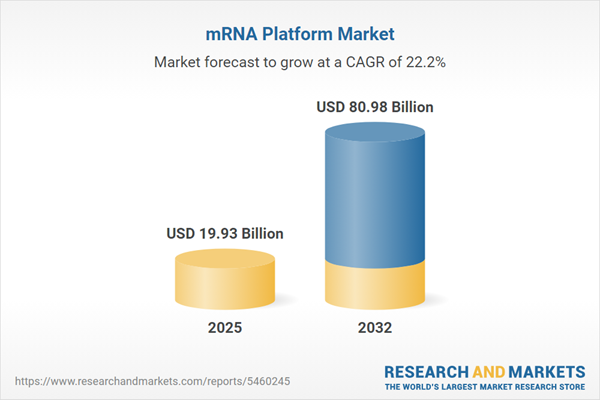Speak directly to the analyst to clarify any post sales queries you may have.
The mRNA platform market is driving a new wave of healthcare innovation, demanding that senior decision-makers re-evaluate core growth strategies, resource allocation, and operational agility to secure lasting value in an evolving global landscape.
Market Snapshot: Trends and Strategic Outlook in the mRNA Platform Market
The mRNA platform market is achieving robust expansion, sustained by ongoing breakthroughs initially observed in vaccine development and now extending to diagnostics, therapeutics, and advanced research. Adoption has shifted from targeted immunization programs to broader, more adaptable uses across main healthcare segments. Key technology advancements—including efficient scalability and lipid nanoparticle delivery—have streamlined the transition from research pipeline to commercial offerings. This facilitates new market entry points for pharmaceutical companies, biotech leaders, and academic research partners, who collaborate to support resilience and meet dynamic medical priorities through strategic partnerships and sustained investment.
Scope & Segmentation
This executive report delivers detailed analysis for decision-makers assessing strategic opportunities in the mRNA platform market. Covered segmentation highlights the most relevant drivers and application areas critical to organizations' future success:
- Product Types: Diagnostics tailored for oncology and infectious diseases; reagents designed for precise molecular screening; research kits leveraging updated lipid nanoparticle methods; therapeutics targeting areas such as cardiovascular, neurological, oncological, and rare diseases; preventive and therapeutic vaccine solutions.
- Therapeutic Areas: Cardiological solutions addressing complex disorders; broad infectious disease measures for diverse populations; neurological product development in support of degenerative conditions; oncology-focused products for a range of tumor classes; rare disease applications including genetic and metabolic indications.
- End Users: Academic research centers; diagnostics labs expanding patient access; hospital providers adopting mRNA-centric treatments; pharmaceutical manufacturers enhancing development cycles; specialized healthcare centers working toward optimized outcomes.
- Geographies: Market analysis spans North America, Latin America, major European countries (including the UK, Germany, France, Russia), and emerging EMEA regions such as the UAE, South Africa, and Nigeria. The Asia-Pacific review covers China, India, Japan, Australia, South Korea, Indonesia, Thailand, Malaysia, Singapore, and Taiwan, with focus on local regulatory trends, market adoption speeds, and clinical priorities.
- Key Companies: Modern mRNA breakthroughs are led by organizations such as Moderna, BioNTech, CureVac, Pfizer, and Sanofi, actively shaping the market's next phase through investment and commercial development.
Key Takeaways
- mRNA platform integration allows senior executives to future-proof both diagnostic and therapeutic portfolios, setting a foundation for swift adaptation to evolving sector challenges.
- Lipid nanoparticle innovation and increased adoption of machine learning tools are simplifying movement from discovery to commercial solutions, making next-generation technologies more accessible to market participants.
- Shifting regulatory frameworks are encouraging faster approval pathways, benefiting established leaders and new entrants by reducing uncertainty and minimizing administrative delays.
- Strategic collaborations across pharmaceuticals, biotech firms, and academic entities maintain supply chain integrity, encourage manufacturing efficiency, and support strategies aligned with emerging health trends.
- Focused investment in neurological and rare disease segments is advancing portfolio diversity and enabling precision approaches for underserved patient communities, strengthening access to untapped market opportunities.
- Maintaining proprietary advances in synthetic biology and delivery technology remains critical for defending competitive positioning as market complexity increases and innovation accelerates.
Tariff Impact: Supply Chain and Procurement Realignment
Recent US tariff adjustments are prompting organizations to update procurement practices, increasing engagement with local suppliers and scaling domestic manufacturing initiatives. These responses are designed to stabilize costs and reduce exposure to volatility in global supply chains. Procurement and compliance leaders are refining inventory strategies and maintaining oversight of policy shifts to safeguard operational continuity and delivery reliability.
Methodology & Data Sources
This assessment draws on senior executive interviews, peer-reviewed journal data, ongoing patent monitoring, and frequent regulatory updates from leading health authorities. These combined insights provide a strategic foundation for leaders evaluating action steps in the advancing mRNA platform sector.
Why This Report Matters
- Supports leadership in formulating responsive investment and partnership frameworks suited to a high-velocity, innovation-driven environment.
- Clarifies implementation pathways for emerging mRNA technologies, aiding structured risk management and reinforcing market entry planning.
- Provides focused guidance for managing regulatory diversity and geographic expansion, helping executive teams streamline portfolio integration and future growth.
Conclusion
Organizations that prioritize agile planning, cross-sector collaboration, and adaptability are best positioned to realize opportunities in the fast-maturing mRNA platform market. Continual innovation and partnership will drive market momentum moving forward.
Additional Product Information:
- Purchase of this report includes 1 year online access with quarterly updates.
- This report can be updated on request. Please contact our Customer Experience team using the Ask a Question widget on our website.
Table of Contents
3. Executive Summary
4. Market Overview
7. Cumulative Impact of Artificial Intelligence 2025
Companies Mentioned
The companies profiled in this mRNA Platform market report include:- Moderna, Inc.
- BioNTech SE
- CureVac SE
- Arcturus Therapeutics Holdings, Inc.
- Pfizer Inc.
- Sanofi S.A.
- GlaxoSmithKline plc
- Vaxart, Inc.
- Gritstone bio, Inc.
- Providence Therapeutics Holdings Inc.
Table Information
| Report Attribute | Details |
|---|---|
| No. of Pages | 184 |
| Published | October 2025 |
| Forecast Period | 2025 - 2032 |
| Estimated Market Value ( USD | $ 19.93 Billion |
| Forecasted Market Value ( USD | $ 80.98 Billion |
| Compound Annual Growth Rate | 22.1% |
| Regions Covered | Global |
| No. of Companies Mentioned | 11 |









